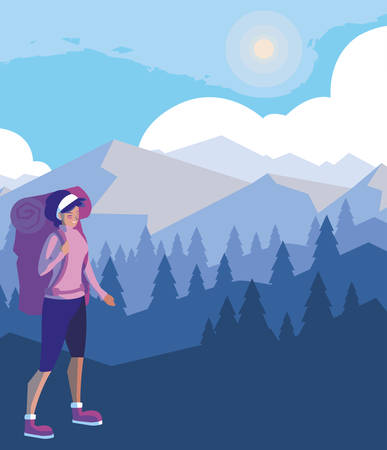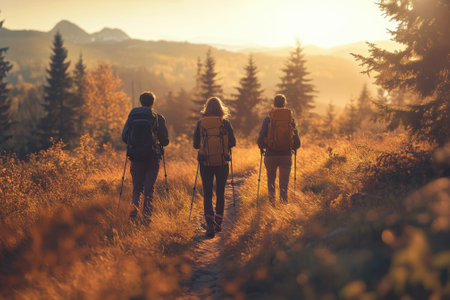1. Building Stronger Family Bonds
Hiking together is a beloved tradition for many American families. It offers a unique way to step away from busy schedules and digital distractions, allowing family members to connect in the great outdoors. Unlike sitting around the dinner table or watching TV, hiking encourages real conversations and teamwork as everyone navigates the trail together.
Connecting Through Shared Experiences
When families hike, they share both the challenges and joys of the journey. Whether it’s climbing a steep hill or spotting wildlife along the path, these moments become shared memories that bring everyone closer. The simple act of walking side by side makes it easy to talk, laugh, and support each other without the interruptions of everyday life.
Strengthening Relationships Beyond Routine
In American culture, where work, school, and activities often keep families apart, hiking provides a chance to slow down and be present with one another. Parents and children can enjoy quality time, siblings can bond through playful competition or teamwork, and everyone learns more about each other outside their usual roles at home.
How Hiking Strengthens Family Bonds
| Activity | Benefit |
|---|---|
| Walking Together on Trails | Encourages open conversation and active listening |
| Overcoming Trail Challenges | Builds trust and teamwork among family members |
| Exploring Nature as a Group | Creates shared memories and strengthens emotional connections |
| Taking Breaks & Picnicking Together | Promotes relaxation and fun bonding moments |
Family hikes not only strengthen relationships but also help create lasting traditions that children will remember fondly into adulthood. By making time for outdoor adventures together, families can grow closer while enjoying everything America’s natural landscapes have to offer.
2. Fostering Healthy Lifestyles
The Role of Family Hiking in Physical Activity
Hiking together as a family is more than just a way to enjoy the outdoors—it’s an excellent way to encourage everyone to stay active. In American culture, spending time outside and getting regular exercise are seen as important parts of a healthy lifestyle. Family hikes offer a fun and natural way for people of all ages to move their bodies, whether it’s an easy walk on a local trail or a challenging trek through the mountains.
Promoting Wellness Across Generations
One of the best things about hiking is that it brings together grandparents, parents, and kids. When families hike together, they share positive experiences while getting fresh air and exercise. This shared activity promotes both physical and mental wellness, helping everyone feel less stressed and more connected. It also provides a welcome break from screens and busy schedules, making room for laughter, conversation, and relaxation in nature.
Benefits of Family Hiking at Every Age
| Age Group | Physical Benefits | Mental & Social Benefits |
|---|---|---|
| Children | Builds strong bones & muscles, improves coordination | Encourages curiosity, boosts confidence |
| Teens | Supports fitness, develops endurance | Reduces stress, strengthens family bonds |
| Adults | Helps maintain healthy weight, lowers risk of chronic disease | Relieves work-related stress, creates memories with loved ones |
| Seniors | Improves mobility & balance, supports heart health | Counters isolation, increases joy through shared experiences |
Instilling Lifelong Healthy Habits
When families make hiking a regular tradition, they set an example for younger generations. Kids who grow up hiking with their parents are more likely to continue being active as adults. This tradition can lead to lifelong habits that support overall health and happiness. In American culture, where healthy living is highly valued, family hiking stands out as an enjoyable way to promote wellness together.

3. Teaching Appreciation for Nature
Hiking together as a family is about more than just exercise or spending time outdoors—it’s an opportunity to help everyone, especially kids, develop a true respect for the environment. In the United States, where natural beauty stretches from coast to coast, family hikes play a big role in teaching the next generation to value and care for our wild spaces.
Learning by Experience
When families hit the trails, children get hands-on experiences that can’t be matched by reading books or watching videos. They learn how different plants look, notice animal tracks, and see firsthand how important it is to leave no trace behind. This helps them build real connections with nature and understand why we need to protect it.
Discovering America’s Diverse Landscapes
The U.S. is famous for its variety of landscapes—majestic mountains, peaceful forests, sweeping deserts, and stunning coastlines. Family hikes give everyone a chance to explore these unique places and see what makes each one special. Here’s a simple look at some popular American landscapes families might visit:
| Landscape Type | Popular Locations | What You Can Learn |
|---|---|---|
| Mountains | Rocky Mountains, Appalachians | Geology, wildlife, altitude changes |
| Forests | Redwoods in California, Smoky Mountains | Plant diversity, forest ecosystems |
| Deserts | Grand Canyon, Joshua Tree | Desert survival, unique plants and animals |
| Coastlines | Pacific Coast Trail, Acadia National Park | Tide pools, marine life, erosion effects |
The American Tradition of Stewardship
Family hikes often include small lessons on how to care for nature—like picking up trash or staying on marked paths. These habits teach kids about stewardship, a core value in American outdoor culture. When families work together to keep trails clean and respect wildlife habitats, they’re passing down important traditions that will help preserve these beautiful places for years to come.
4. Encouraging Communication and Teamwork
Hiking together as a family is about much more than just enjoying the great outdoors. On American trails, families find unique chances to talk, work together, and build stronger bonds. When everyone faces the same path—steep hills, winding turns, or rocky patches—it creates natural moments for open conversation and teamwork.
Opportunities for Open Conversation
Without the distractions of daily life, hiking gives family members time to connect. Parents and kids can share stories, talk about their days, or discuss hopes and dreams. The relaxed pace of walking side by side helps everyone feel comfortable opening up.
How Hiking Supports Family Communication
| Situation on Trail | Conversation Opportunity |
|---|---|
| Taking a break at a scenic overlook | Share thoughts about nature or feelings |
| Helping each other over rough terrain | Encourage teamwork and problem-solving talk |
| Choosing which trail to take next | Practice decision-making as a group |
Problem-Solving Together
Navigating trails often brings small challenges—like finding the right path, crossing streams, or handling tired feet. These are chances for families to solve problems as a team. Kids learn that everyone’s input matters, and parents can model positive ways to handle setbacks.
The Benefits of Teamwork on Hikes
- Building Trust: Relying on each other boosts confidence in family relationships.
- Learning Patience: Waiting for one another teaches empathy and respect.
- Sharing Leadership: Kids can take the lead sometimes, giving them a sense of responsibility.
Every Step Counts
Whether you’re crossing creeks in the Rockies or strolling through local state parks, every shared step is a chance to strengthen your family’s communication and teamwork skills—qualities that matter both on and off the trail.
5. Connecting with American Traditions
Hiking together as a family is more than just exercise—its a way to experience values that are deeply rooted in American culture. Outdoor recreation, especially hiking, has always been an important part of life in the United States. It connects us with traditions that celebrate self-reliance, adventure, and community.
Hiking and Core American Values
| Value | How Hiking Supports It |
|---|---|
| Self-Reliance | Families learn to prepare for hikes, read trail maps, and rely on each other’s skills. |
| Adventure | Exploring new trails and discovering nature brings excitement and curiosity into family life. |
| Community | Hiking often happens in groups, local parks, or public lands where people come together and support each other. |
The Role of Hiking in American History
Americans have a long tradition of exploring the outdoors. From the early pioneers crossing rugged terrain to today’s families visiting national parks, outdoor adventures have always shaped our identity. Popular sayings like “Take a hike!” or “Hit the trail!” show how much hiking is part of everyday language and culture.
Modern Family Hikes: A Shared Experience
Today, hiking remains one of the most accessible ways for families to spend time together. It gives parents a chance to pass down stories, knowledge about nature, and respect for the environment. Children can build confidence by achieving small goals like reaching a viewpoint or finishing a trail.
Why These Traditions Matter Now
In a fast-paced world filled with technology, family hikes offer an opportunity to slow down and reconnect—with nature and with each other. They keep alive the spirit of adventure that has always been a key part of American life. By hiking together, families not only stay active but also become part of a tradition that celebrates independence, exploration, and strong community bonds.


